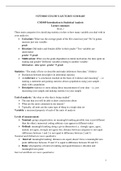Summary
CM1005 Summary - Introduction to Statistical Analysis @EUR
- Course
- Institution
The document includes a summary of all the lectures from week 1 to 8 of the course Introduction to Statistical Analysis. Besides a summary of the content, you may find the most relevant slides from the lectures, which clarify the various statistical methods used for analysis by taking a closer look...
[Show more]



